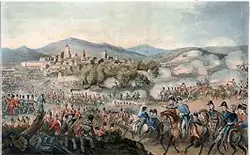Joseph Bonaparte: King of Spain and Naples
Part 3: Later Life Bonaparte reigned from afar, as a civil war engulfed the country. He found his reign troubled as well by a series of sometimes contradictory orders from his brother, who had accompanied a contingent of French troops to Spain and had fought there for some time before returning to what he termed more urgent needs in Central Europe. Joseph, meanwhile, struggled on, combating not only a fierce opposition from most of the Spanish people but also a propensity of the French commanders to insist on getting their orders from Napoleon, even when he was in France. In 1812, Joseph insisted that he wanted no more of the Spanish kingship. Napoleon refused, instead solving the chain-of-command problem by making Joseph commander-in-chief of all French forces in Spain. 
In charge of the Anglo-Portuguese forces opposing the French occupation was Arthur Wellesley, more well-known as the Duke of Wellington. At the height of occupation, France had committed 300,000 troops to the effort to control Portugal and Spain. Because of the fierceness of the opposition within Spain, however, the French were able to count on only about one-quarter of that occupation force to do battle with England and Portugal at any one time. Even so, at the end of 1811, French troops occupied the vast majority of Spanish territory. Wellington went on the offensive in 1812, entering Spain at the head of an allied army and seizing the strongholds of Ciudad Rodrigo (in January) and Badajoz (in April). In July, the allies defeated the French at the Battle of Salamanca. A month later, Wellington seized Madrid. Joseph could no longer count on any help from his brother because Napoleon had invaded Russia in 1812. Against his generals' advice, Joseph ordered the French forces to engage Wellington at Vitoria, in June 1813. The result was an emphatic victory for Wellington's forces. At that point, Joseph Bonaparte declared himself free of the responsibilities of kingship and left the country, returning to France. Wellington and Allied troops rolled onward, cementing control of Spain, entering France, and then reaching Paris, in March 1814. At that point, Joseph and family left for good, settling in Switzerland. When his brother escaped from Elba in 1815, Joseph and his family went back to Paris. After Napoleon's defeat at the Battle of Waterloo, however, Joseph decided to sail to the United States. He found a ship, the Commerce that would take him there. (His wife and children had agreed to stay behind, in Paris.) He offered his brother his own spot on the ship, but Napoleon refused. When Napoleon surrendered himself, Joseph left. He had traveling papers under an assumed name and escaped British detection twice before successfully arriving in New York, on Aug. 28, 1815. 
Bonaparte, not wanting undue attention to himself, assumed the title of the Count of Survilliers. (It was the name of a small place that he owned near Mortefontaine, in France.) He found a way to get most of his fortune into American banks and bought the estate Point Breeze, in Bordentown, N.J., and a large plot of land in northern New York. On that plot of land, which was often called Bonaparte's Park, was a 1,200-acre lake that he named Lake Diana. (It is now Lake Bonaparte.) Bonaparte had also rented a house in Philadelphia, and it was at this place and the others he owned that others sympathetic to the Napoleonic cause came after fleeing France. He also made many friends in his new country and won election to the American Philosophical Society, following in the footsteps of many of America's Founding Fathers. 
The Point Breeze house burned in a fire on Jan. 4, 1820. Bonaparte was away at the time, and his neighbors saved as much of his possessions as they could safely extract. He rebuilt the house in finer style, including a library that held 8,000 books and an art gallery that had a version of Jacque Louis David's painting of Napoleon crossing the Alps. Living with him for a time were his daughter Zénaïde and her husband, Charles-Lucien Bonaparte; they lived in Lake House, which was connected to the main house by a tunnel. Bonaparte saw an opportunity after the July Revolution of 1830 removed France's Charles X and bought a French-language newspaper in America to promote the cause of his nephew, Napoleon II, to take over the throne. The French people had other ideas, choosing Louis Philippe as their new leader. Bonaparte moved to London in 1832. After suffering a paralysis-inducing stroke, in 1840, he moved to Italy and reunited with his wife after many years apart. He was in Florence when he died, on July 28, 1844. He was 76. First page > Early Years > Page 1, 2, 3 |
|
Social Studies for Kids
copyright 2002–2024
David White




